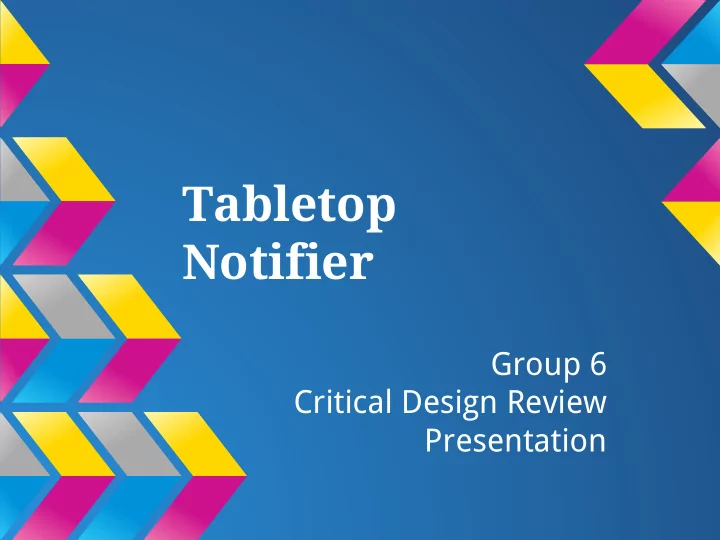

Tabletop Notifier Group 6 Critical Design Review Presentation
Motivation ● Tabletop display for wirelessly presenting and interacting with smartphone notifications ● Placed on a desk, countertop, or bedside for viewing messages and other notifications without need to operate phone
Basic Features ● Always-on clock to display the current time ● Receive text message, email, or other notifications wirelessly from paired smartphone using Bluetooth ● Display the text message, email, or other notification received from the paired smartphone ● Companion Android application/service for configuration and communication.
Stretch Features ● Bluetooth audio output (music) ● Bluetooth audio input (speakerphone) ● Rich interaction with notifications ○ physical buttons, or ○ touch enabled display ● Alarms ● other “apps”?
Design | Hardware ● Bluetooth Module ○ UART ○ Audio interface ● LCD Controller ○ SPI ● Touchscreen Controller ○ SPI
Hardware Block Diagram
Design | Software Android uCOS II ● Tasks ● Connection and ○ receive notification configuration interface data from Bluetooth ○ Activities, Fragments ○ parse notifications ● Bluetooth ○ write to LCD communication and ○ system apps (clock, notification capture ○ Services etc.) ● Port of LCD drivers from ○ Android Bluetooth Arduino API ○ JSON
Dataflow Diagram
Code Sample (1) /* Data object to model */ struct notification { char title[SIZE]; char text[SIZE]; }; /* Object specific parsing function */ static int json_notif_read(const char *buf, struct notification *notif) { /* Mapping of JSON attributes to C object's struct members */ const struct json_attr_t json_attrs[] = { {"title", t_string, .addr.string = notif->title, .len = sizeof(notif->title)}, {"text", t_string, .addr.string = notif->text, .len = sizeof(notif->text)}, {NULL}, }; /* Parse the JSON object from buffer */ return json_read_object(buf, json_attrs, NULL); }
Code Sample (2) int main(int argc, char *argv[]) { /* Allocate space for object */ struct notification *my_notif = malloc(sizeof(struct notification)); /* Call object parsing function */ int status = json_notif_read(argv[1], my_notif); if (status == 0) { printf("Title: %s\n", my_notif->title); printf("Text: %s\n", my_notif->text); } else { puts(json_error_string(status)); } return status; } ./microjson_demo '{"title":"my test title","text":"my test text"}' Title: my test title Text: my test text
App Notes Possible Topics ● Android ○ accessing notifications from the operating system ○ Bluetooth API and Serial Port Profile ○ Android Test Framework ● C ○ port of LCD drivers ○ port of touchscreen drivers ○ parsing JSON on uCOS II with microjson library
Test Plan | Software Android µCOS ● Unit tests written in ● Written µCOS tasks will Android Test Framework be first tested on the (JUnit) DE2 using the on-board ● Communication over 16X2 character display Bluetooth SPP tested by ● Until Bluetooth connecting to PC capabilities have been terminal established, on-board push-buttons can be used to simulate incoming notifications ● So far...
Test Plan | Hardware Altera De2 ● v1.0 - Basics (16x2, LEDS, Buttons) ● v2.0 - Includes UART Altera core ● v3.0 - Includes SPI Altera cores (LCD, touchscreen) ● v4.0 - transfer to Non-Volatile memory
Backup Plans ● Character LCD ○ If we can’t get the drivers working for the LCD display controller Push Button Interface ● ○ If we can’t get the drivers working for the Resistive Touchscreen Controller
Recommend
More recommend